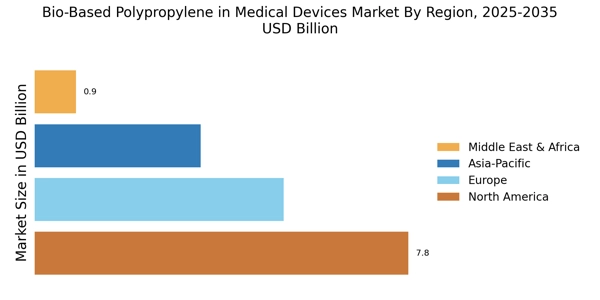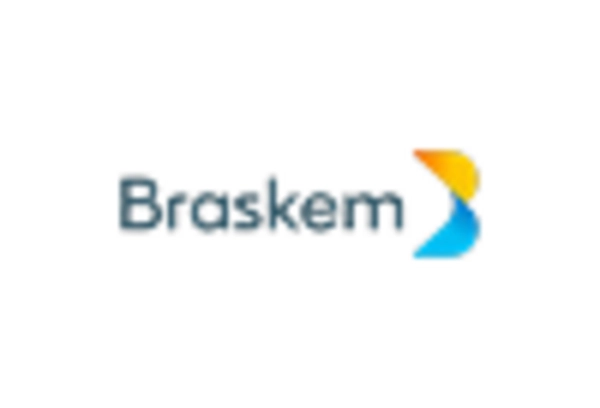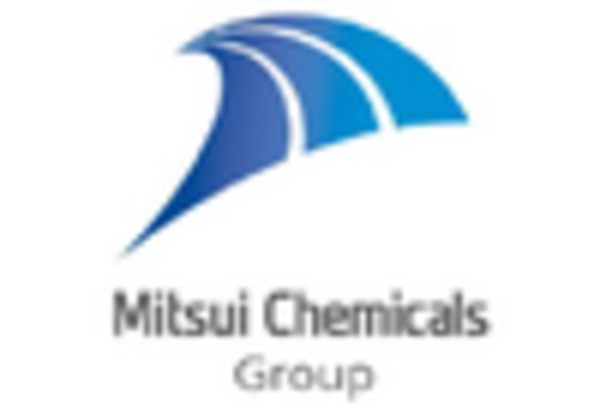Regulatory Support
Regulatory frameworks that promote the use of sustainable materials in medical devices are likely to bolster the Bio-Based Polypropylene In Medical Device Market. Various health authorities and environmental agencies are increasingly advocating for the adoption of bio-based materials, recognizing their potential to reduce environmental impact. For instance, regulations that incentivize the use of renewable resources in medical manufacturing could lead to a surge in demand for bio-based polypropylene. The market is expected to benefit from these supportive policies, as manufacturers seek to comply with evolving regulations while also appealing to environmentally conscious consumers. As a result, the Bio-Based Polypropylene In Medical Device Market may witness accelerated growth, driven by favorable regulatory conditions that encourage the transition to sustainable materials.
Technological Innovations
Technological advancements in material science and processing techniques are likely to enhance the performance and applicability of bio-based polypropylene in the medical device sector. Innovations such as improved polymerization methods and enhanced material properties could lead to the development of more effective and versatile medical devices. For instance, bio-based polypropylene can be engineered to exhibit superior mechanical strength and biocompatibility, making it suitable for a wider range of applications. The Bio-Based Polypropylene In Medical Device Market may experience growth as manufacturers leverage these technological innovations to create high-performance products. Furthermore, the integration of smart technologies into medical devices could further drive the demand for advanced materials, including bio-based options, as the industry seeks to improve patient outcomes and operational efficiency.
Sustainability Initiatives
The increasing emphasis on sustainability within the healthcare sector appears to drive the Bio-Based Polypropylene In Medical Device Market. As healthcare providers and manufacturers seek to reduce their environmental footprint, the demand for bio-based materials is likely to rise. Bio-based polypropylene, derived from renewable resources, offers a more sustainable alternative to traditional petroleum-based plastics. This shift aligns with broader sustainability initiatives, as many organizations aim to achieve carbon neutrality by 2030. The market for bio-based plastics is projected to grow at a compound annual growth rate of approximately 15% over the next five years, indicating a robust interest in sustainable materials. Consequently, the Bio-Based Polypropylene In Medical Device Market is poised to benefit from this trend, as manufacturers increasingly adopt eco-friendly materials in their product lines.
Consumer Demand for Eco-Friendly Products
The rising consumer awareness regarding environmental issues is likely to influence the Bio-Based Polypropylene In Medical Device Market. Patients and healthcare providers are increasingly seeking eco-friendly products, prompting manufacturers to explore sustainable alternatives. This shift in consumer preferences is reflected in the growing demand for medical devices made from bio-based materials, which are perceived as safer and more environmentally responsible. Market Research Future indicates that approximately 60% of consumers are willing to pay a premium for eco-friendly medical products, suggesting a significant opportunity for growth in the bio-based sector. As manufacturers respond to this demand, the Bio-Based Polypropylene In Medical Device Market is expected to expand, driven by the need to align product offerings with consumer values.
Cost-Effectiveness of Bio-Based Materials
The potential cost advantages associated with bio-based polypropylene may serve as a catalyst for its adoption in the medical device sector. As production technologies advance and economies of scale are achieved, the cost of bio-based materials is likely to decrease, making them more competitive with traditional plastics. This cost-effectiveness could encourage manufacturers to incorporate bio-based polypropylene into their product lines, thereby driving growth in the Bio-Based Polypropylene In Medical Device Market. Additionally, the long-term savings associated with reduced environmental impact and compliance with regulations may further enhance the appeal of bio-based materials. As the market evolves, the financial viability of bio-based polypropylene is expected to improve, potentially leading to increased market penetration and wider acceptance within the medical device industry.


















Leave a Comment